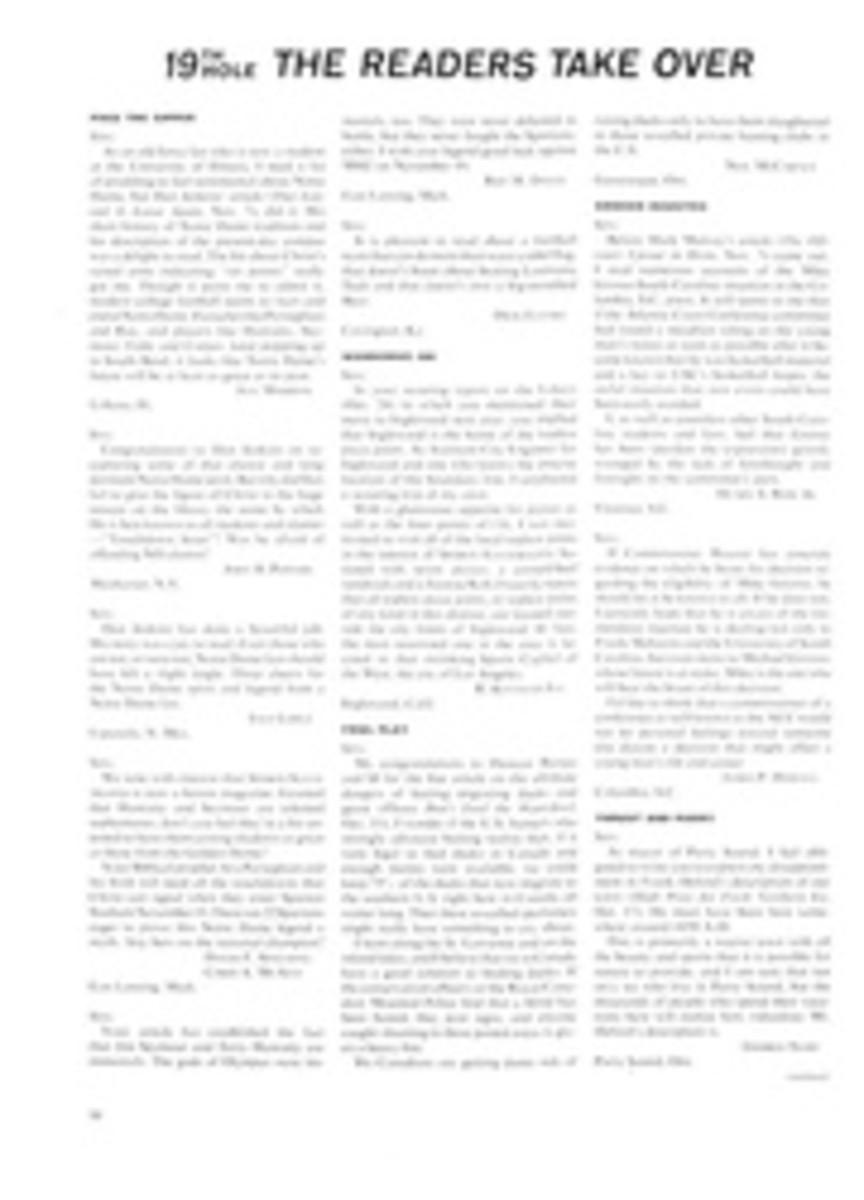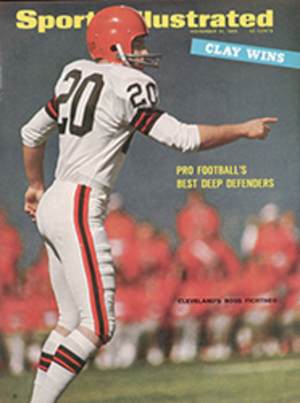
THE FRENCH AND THE PHIPPSES
Near the end of a long, long season that at times became tedious because its quality was diluted, racing last week offered back-to-back attractions of both worldwide and national significance. On Friday, in the 15th running of the Washington, D.C. International at Laurel, Md., France once again proved that she produces almost unbeatable turf distance runners. Alec Weisweiller's Behistoun ran away from nine rivals (including the two best Americans, Assagai and Tom Rolfe) at the end of the classic mile and a half. Twenty-four hours later, at New Jersey's Garden State Park, the 2-year-old championship was settled. Successor, who is owned, curiously enough, by some people named Phipps, swamped 11 other colts in the slop to become an early winter book favorite—along with some other Phipps horses, of course—for the 1967 Kentucky Derby.
It was a rousing weekend of top sport, marred only slightly by the Jersey rains that followed an ideal Indian summer afternoon in Maryland. International horse racing is no longer a yawn-producing cocktail-conversation topic to be indulged in by members of the world's Jockey Clubs. It is a reality, a going concern, and is headed for a busy future. Its growth has been nurtured by such obvious factors as faster and more efficient jet cargo transportation and a significant increase in French, English and Irish major stakes purse distribution. And it assumes greater importance in this country as our tracks turn more and more to grass racing and Promoter John Schapiro continues to attract some exceptionally fine runners for his $150,000 race at Laurel.
Last week's International was a true spectacular on several counts. For one thing, after the first 14 runnings the score stood all even: seven U.S. victories and seven for the invaders, four achieved by the French. For another, this race brought together most of the world's leading jockeys to test their skills over a tight and tricky 12-furlong route. Only Braulio Baeza, who was to have his moment of glory the following afternoon, was missing as the little men paraded to the infield paddock to mount the International field. There was Bill Shoemaker, riding popular Tom Rolfe. Milo Valenzuela, a winner at Laurel on Kelso in 1964, was back again, this time aboard the Canadian challenger, George Royal. Lester Piggott, the leading rider in England, flew in (on his way to a Nassau vacation with one suit and a pair of shoes with holes in them) to guide David Jack. Back for his eighth ride in the International was Russia's "master jockey" Nikolai Nasibov, aboard Aniline. From France came the amazingly successful Yves Saint-Martin, premier jockey for Champion Trainer Francois Mathet, who was sending out the gray colt Silver Shark in the green-and-red silks of Prince Karim Aga Khan. And last—but not for long—was 31-year-old Jean Deforge, considered the second best rider in France, the winner of the International a year ago on Diatome. It was Deforge's first ride on Behistoun, who had finished a fast-closing fifth in the 24-horse field of last month's Prix de l'Arc de Triomphe.
"The owner and trainer of Behistoun came to me after the Arc," said Deforge, whose broad, handsome face is slightly scarred as the result of an automobile accident several years ago. "They asked me to go back to Laurel with their horse. They pointed out that, in the Arc, Behistoun, a very late runner, had to come from way back and try to get by 23 horses to win. He nearly made it, though he got into some trouble. Still, he lost by only four and a half lengths. So they figured that in a smaller field at Laurel, and with a jockey who knew the course as I did, they had a chance to win, no matter what the opposition."
Deforge's reasoning was perfect, and he achieved his second straight International victory with a dramatic run that astonished and thrilled the crowd of 30,843. The favorite, justifiably, was Charlie Engelhard's 3-year-old Assagai, winner of eight of his last 11 starts and six of his seven races over grass. Tom Rolfe, the other U.S. entry, had tailed off noticeably in recent weeks. A fortnight before the International "he was life and death to beat ordinary horses," said Shoemaker. "He didn't look good enough to win a stakes, certainly not in this sort of competition."
The question-mark horses in the field were George Royal, Silver Shark and Aniline. George Royal was fourth in the International last year, beaten only a shade more than a length by the trio of Diatome, Carvin and Roman Brother. Prince Karim's Silver Shark, many believed, would not even be in America unless Trainer Mathet thought he had a chance to win. The young Aga Khan made his first trip to Laurel to see the race and, as he hobbled about with a cane, still recuperating from a fall three months ago, he explained why Mathet was not present. "He's busy racing in Paris, you know, and besides, he wasn't here the only other time he won. Maybe this is a good omen, no?"
As things turned out, it wasn't a particularly good omen. Mathet should have kept his colt out of the International, just as he had withheld him from the Arc. Russia's Aniline was something else. He had been immensely popular here two years ago, as Jockey Nasibov has been since his first appearance in this country in 1958, when he wrapped up his riding gear in old newspapers before walking back across the infield after the race. Aniline added to his stature in 1965 by finishing fifth in the Arc de Triomphe, some five lengths ahead of sixth-place Tom Rolfe. Since then he had won all six of his starts, including two victories in the mile-and-a-half Preis von Europa in Cologne.
Two other invitees, Brazil's Folio and Venezuela's Socopo, were under silks more or less as window dressing. They looked handsome, but finished as expected: ninth and tenth. Ahead of them was England's David Jack, who had acted up in the paddock and on the way to the post and ultimately gave up after running a decent 10 furlongs. "He just can't get the trip. It's too far for him," conceded Jockey Lester Piggott later. At the wire with him was George Royal, who ran with a troubled ankle.
From the moment Starter Eddie Blind sprang the gate it was Aniline who took control of the race. The grass was somewhat yielding after Thursday's rain, spoiling any chance for Tom Rolfe, who likes his running surfaces hard and solid, but Aniline thrived on it, eating up the furlongs with long, powerful strides. Larry Adams tracked him carefully with Assagai about a length and a half away, and none of the others seemed to be in the hunt until the field turned for home. Vasco de Gama, France's third entry, held tenaciously to third place for the early running, while Deforge had Behistoun back in ninth place after a mile.
But it was in the last quarter of a mile that the drama took place. Nasibov, on the lead, kept looking around at Adams and Assagai, and both jocks were saving their punch for the stretch. While they waited, Deforge was acting out a script of his own. It could have been called Gone With the Wind. With a quarter of a mile to go, when he was in seventh place and five lengths behind, Deforge gave Behistoun the "En avant" command, and around the field they came. At the eighth pole they trailed Aniline by two and a half lengths, and Assagai by one. "It wasn't that Deforge caught the Russian or me sleeping," said a flabbergasted Larry Adams later. "We were both riding all out by then, but the French horse came by us both like lightning and just kept on going. There was nothing either of us could do about it." At the 16th pole Behistoun took the lead, and he increased it to more than two lengths over Aniline before he hit the wire.
Even though Jockey Deforge insists that Behistoun is inferior to his last year's winner, Diatome, and, in fact, is barely considered to be among the top half a dozen 3-year-olds in France, this latest French victory has far-reaching significance. It may be true that horses accustomed to racing up to and beyond two miles on a difficult course like Longchamp should have the stamina to beat American-breds, who rarely make a career out of distance races. But it is also true that even the English and Irish are having diminishing success against the French. One reason is that French breeders are making careful use of certain strains of U.S. bloodlines—something most English and Irish breeders have long considered beneath their dignity. Behistoun, for example, is a son of O'Grady, who in turn is a son of American-bred Relic, a grandson of Man o' War. It is partly by blending the blood of such stallions as Relic and Native Dancer with some of their own great stock that the French have been so successful.
In The Garden State, Successor's ridiculously easy three-length victory over George Widener's Bold Hour summed up the 2-year-old year, and the championship was decided as it should be—on the track instead of at the ballot box. Those two fine colts had stood out for much of the season, along with In Reality and Dr. Fager. When the latter retired for the remainder of the year, it became obvious that if one of the other three won The Garden State he would deserve the title.
Successor's triumph was hardly surprising. He is a full brother to former champion Bold Lad, is 4 for 9 on the season and should improve on this record as a 3-year-old. In The Garden State, Braulio Bacza kept him back in fifth place for much of the early running while John Rotz set out to steal the whole pot ($188,475 to the winner) with Bold Hour. "With all the mud and slop," said Rotz, "we thought we'd put him on the lead and hope he'd last it. And until the head of the stretch I thought we had it, too."
In Reality stayed close to Bold Hour until the eighth pole in this mile-and-a-16th splash. When they turned for home Rotz took Bold Hour out from the rail and into better going, while In Reality stayed in close. Behind them Baeza drove Successor outside of Jovial Boy and Dawn Glory (an international invader from Puerto Rico) and then neatly broke through between In Reality and Bold Hour to win going away in 1:44[1/5]. Bold Hour, three lengths behind, was six ahead of Proviso, who came with a rush from dead last to beat out In Reality by three-quarters of a length.
Successor will have much to say about the 1967 classics, but the Phipps stable is so loaded, with both first-stringers and a bench, that Trainer Eddie Neloy announced after the race that Successor will not run again until late March. He will miss Hialeah's traditional Flamingo. "Our big Hialeah horses," Neloy said, "will be Great Power and Bold Monarch." The way things are going for the Phippses, that could be enough.
PHOTO
Jockey Jean Deforge's Ioose rein was all the prompting that Behistoun needed to overtake Aniline in the stretch and win going away.
PHOTO
Flying mud forgotten, Braulio Baeza cheerfully plucks a mum from the winner's wreath after riding Successor to the 2-year-old championship.

